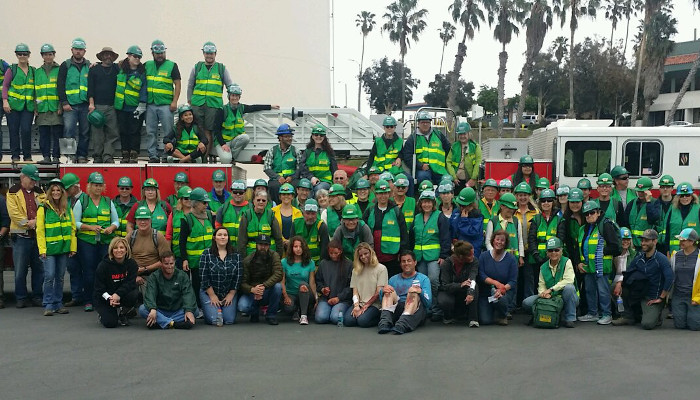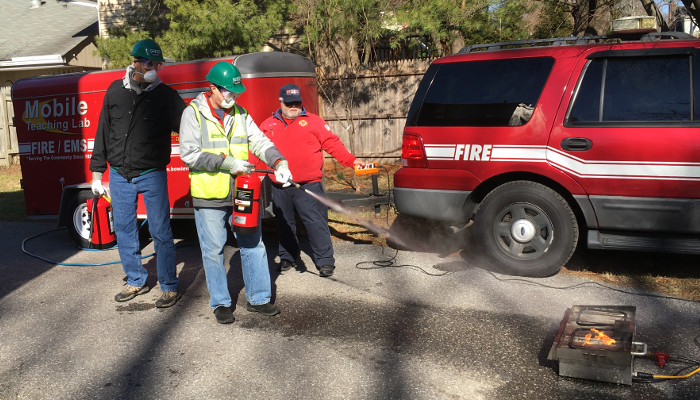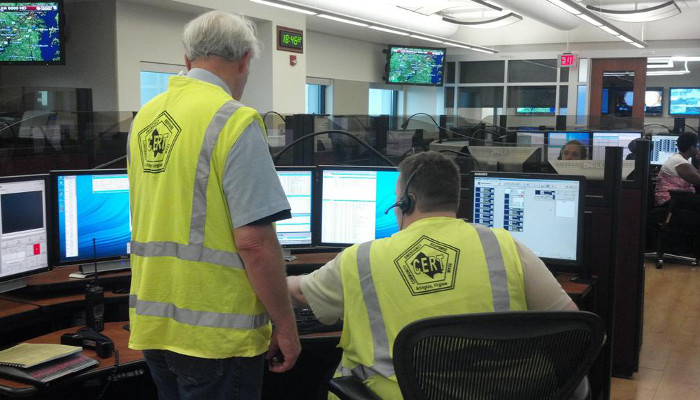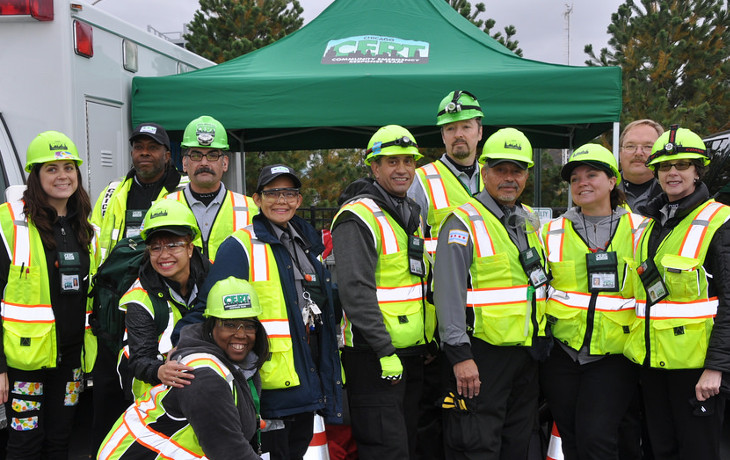“You are the help until help arrives,” declares the Federal Emergency Management Agency (FEMA) in its call for Community Emergency Response Team (CERT) volunteers.
The CERT program trains laypeople to assist professional first responders when a disaster strikes. These volunteers are a “force multiplier,” taking care of tasks like checking homes after an evacuation or reporting dangerous events or areas as they’re discovered. This helps the overworked professionals focus on more dangerous and critical tasks.
“I want to be part of the recovery. I prep to help my community, not just to sit around alone in a bunker feeling happy that I was right.”
— Selcuk A.
600,000 Americans have taken this free course. Considering the prepper community has a difficult time agreeing on anything, the amount of positive reviews and recommendations for CERT courses among survivalists is a strong endorsement.
FEMA works with state and local agencies to design training programs, creating a consistent foundation across the country. Seasoned local first responders do the teaching and offer a special focus on the kinds of emergencies volunteers are most likely to face in their own area.
Twenty-eight states and Puerto Rico offer CERT training, sometimes called NET or NERT for Neighborhood instead of Community — you can find nearby programs via ZIP code. The free 20-hour course includes extensive hands-on practice. Most local programs schedule it over four non-consecutive days, although you can find options ranging from one weekend to spread out over 10 weeks.
If your area doesn’t offer it, or if your life doesn’t fit with that schedule, you can still get a free taste of CERT training online.
Who this is for
You should consider CERT training if you:
- are new to prepping.
- would like a broad refresher.
- want to meet your local emergency professionals.
- would like to make new preparedness-minded friends.
- want to physically get out and help your community in an emergency.
If you’re an experienced prepper, or have recently gone through courses such as first aid or wilderness first responder, you might find the overall CERT courses to be too basic.

However, some seasoned preppers still say they found the time to be a worthy investment. You can make valuable connections with your local first responders, see first-hand how the emergency response engine works behind the curtain, and probably pick up a tip or two you’d never considered before.
Anyone can sign up for CERT courses. There are no age restrictions, although usually the youngest are in their early teens.
A few communities have a criminal background check requirement. In some cases the background check is done before starting the course. In other cases, anyone can take the course, but only those who pass the background check can officially become part of the emergency response team.
History
CERT started as a local program with the Los Angeles Fire Department (LAFD) in 1985. The LAFD traveled to Japan to learn how the they responded to earthquakes. By coincidence, an earthquake struck during their visit and LAFD saw first-hand just how helpful the local community was in the response.
Later that year, LAFD traveled to Mexico City after their 8.1 earthquake that killed 10,000 people. They saw how everyday people with no training would step up to help in the immediate aftermath, even digging with their hands to save total strangers.
The same group of Mexican volunteers — now called “Moles” — were crucial after the September, 2017 Mexico City earthquakes. They also traveled to help dig through World Trade Center rubble after September 11 and after the 2004 tsunami in Indonesia.
What if, they wondered, some of the people likeliest to step up and help could be identified, trained, and organized before disaster struck?
When the pilot program volunteers showed how effective they were as force multipliers during the 1987 Whittier Narrows earthquake in Southern California, emergency managers around the country took notice.
FEMA rolled out a national CERT program in 1993. There are now 2,700 active groups with over 600,000 volunteers trained.
What you learn in CERT training

FEMA has the advantage of seeing decades of data and after-action reports from emergencies around the country. This field of view helps FEMA tailor a consistent and relevant training program.
CERT teaches you how to work with the systems we have now — like fire and police departments, EMS squads, and hazardous material (hazmat) teams — when those systems are up against a bigger emergency than usual.
The scenarios preppers sometimes imagine in which social order has broken down and each of us is on our own are not the scenarios CERT prepares you for. That’s just not their mission. They teach you how to be one spoke of the wheel, rather than how to reinvent the wheel.
Since the goal is to train laypeople to help professionals in a crisis, they are not training you to be Jack Bauer or a combat paramedic firefighter superhero.
You’ll learn basic first aid skills and triage, for example, but will also be instructed to radio instructions back to central command if the medical problem is serious enough for a professional.
CERT is a helpful introduction, but to get to a level where you could certify as an EMT or a firefighter usually requires at least 120 hours of training.
The official 20-hour course is broken into sections:
- Preparedness. 2.5 hours. Includes specific disaster risks most relevant to your local community.
- Fire safety and suppression. 2.5 hours. How to identify hazardous materials, put out a small fire, and fire gear.
- Disaster Medical Operations. 5 hours. Triage and assessment, bleeding control, CPR-like airway control. Part first aid, part logistics of emergency medicine.
- Search and Rescue. 2.5 hours. How to sweep areas, assess structural damage, and rescue techniques.
- CERT Organization. 1.5 hours. The logistics of emergencies, Incident Management System, local team organization, and communications.
- Psychology. 1 hour. How to help victims and first responders / yourself.
- Terrorism. 2.5 hours. How to identify what kind of attack has occurred (chemical, nuclear, etc.).
- Review and simulation. 2.5 hours. Written exam followed by a practical simulation test that uses all of the previous skills.
Some communities add extra pieces. For example, the official FEMA course touches on CPR-like skills, such as tilting a victim’s head to open an airway, but it does not qualify you for a CPR certification because they generally don’t think person-by-person CPR is worthwhile in a mass-casualty event. However, some communities add on a little extra to qualify you for CPR at the same time.
Some preppers report that their local classes also included complimentary skills like land navigation, amateur (ham) radio, 911 call center operations, mass casualty management, and animal welfare.
At the end of your course, you receive a certificate or ID card.
Many CERT programs give graduates a free backpack with basic emergency supplies, such as the green helmet, vest, and work gloves seen on this page.
Find CERT training near you
You can search for classes by ZIP code at FEMA’s Citizens’ Corps site.
Procedures for enrolling may vary depending on the state or local group that provides training in your area. Some areas offer basic CERT training only, while others offer supplemental and advanced courses. Your local listing may also tell you how many actual emergencies CERT teams have helped with, what kinds of emergencies they were, and what kinds of work the volunteers did.
Online CERT training courses
Many of CERT’s instructional materials are free and online.
Probably the best place to start is with the independent study version of the basic CERT course, which was designed for volunteers who have already done the classroom training once and need to renew their certification.
There are Spanish language versions available. You can also find videos of all the hands-on components of the classroom course, the instructor guide — even the meta-instructor guide for instructing the instructors.
As the instruction slides remind you more than once, the online course cannot stand in for the classroom version if you would be getting your certification for the first time. The official estimate is that it takes about six hours. We got through it in four, but there was some overlap with our existing EMT training.
What happens after training as a CERT volunteer
You can complete the course, get your free backpack and certificate, and stop — there’s no commitment to join the formal CERT organization or respond to emergencies.
If you decide to volunteer, many local orgs have minimal requirements to maintain membership. You might need to attend two meetings or events per year, for example, or take an annual one-day continual training course for an advanced topic like 911 call center operations.

CERT members who have elected to volunteer are “activated” by local emergency managers for a wide range of situations. In most cases a volunteer is contacted by the authorities and asked to come in. In severe scenarios where communication may be impossible, CERT members are trained to proactively come in on their own — after they’ve made sure that their family is safe.
It’s hard to predict what you might actually do as a CERT volunteer, but these are real-world examples reported by fellow preppers:
- Search and Rescue for a missing child
- Perimeter security during a wildfire
- Search and Rescue homes in an evacuated zone, leaving markings on cleared homes
- Set up and run evacuation shelters
- Set up and run animal shelters during a flood or fire
- Traffic management during an evacuation or after a disaster affected the road system
- Set up and run a vaccination dispensing center during an H1N1 outbreak
- A terrorist threat forcing people out of an apartment building and into a shelter organized by CERT
- Clear beaches and storm surge zones during a tsunami threat
- Perimeter control in high traffic areas with a downed power line
- Run first aid stations during an overwhelming event, like a small town overrun with people watching the solar eclipse
- Assist during a murder investigation
Training and field experience reviews from CERT volunteers

In a lessons-learned overview of Hurricane Sandy as experienced by three CERT teams from small New Jersey towns, communication is the issue the volunteers highlighted in their interviews. The most experienced team, the ones who could look back on Sandy and say, “Practice makes perfect,” and the newest team, certified just seven days before the storm hit, both identified clarity of communication as something they’d advise other teams to work on in preparation for a storm like theirs.
Other community reviews:
“It was great introductory and refresher information to some key topics — but only scratching the surface, as the instructors acknowledged. I’d highly recommend for anyone.” — delawalk
“My husband and I went through CERT last year. We have remained active with the core group and are helping to spread the word to encourage new recruits. We can’t say enough positive things about the organization and our experience! It helped us tremendously in our personal prepping, both psychologically, and actually. It has been the single most influential thing we’ve done in our prepping.” — Michelle
“I took the training over the course of a weekend and it was crammed with fabulous ideas for surviving disaster. Highly recommend it.” — triviaqueen
“While many preppers all go on about bugging out when the bad stuff happens, there’s plenty of room for volunteers to help when there’s a crisis.” — EraserGirl
“I’m very active, volunteering 70-90 hours a month for a couple of years. We have a great CERT team under our Sheriff, but most are under fire departments… I was able to work [at] the Family Assistance Center during the Reno Air Race crash and worked wildfires setting up security areas, setting up animal shelter during emergencies, and so on. Lots of training for emergencies. We got hit with 3 big things in a short period and the training was invaluable. Highly recommend it.” — norinv
“I did the full course. Loved it all and I highly recommend it.” — Anonymous prepper
“For getting a jump start on basic skills [CERT] is helpful and you can use it as a blueprint and just increase the depth of each subject as comfortable. There aren’t too many courses like CERT for lay-rescuers that I am aware of, and it can be a great program as long as you have an organized, motivated group and use the training as a starting point and not an all-inclusive guide.” — SirCastic
“It was very basic (tailored to anyone) and well worth it. I learned a lot, and I find it valuable to be able to interface effectively with first responders in my community.” — The_Pilot_Man2
“My job offered to sponsor me for CERT. I would recommend it. It’s a fantastic way to build more bridges in our local area and see what’s going on if there is a serious emergency. It really helped me understand the basics in my local area’s emergency responder strategies and how average people can be useful in an emergency. It can get your wheels spinning into other subjects of interest too. At the time I was an active lifeguard and school bus driver [and] it showed me how my skills would be employed in an emergency. I felt good knowing I could help beyond my job at the time.”
— Anonymous prepper
“I would recommend it. The courses are informative if you are just starting out. You learn a lot of information so don’t expect too much depth on any one subject. It’s also useful to make inroads into the official LEO / emergency responder community as well, if you aren’t associated yet.”
— realeyes_realize
“It’s worth it, not only does it reinforce the basics, but is a community outreach tool as well. The training was totally worth it.” — SoCalSurvivalist
“CERT/NET is well worth going through. Even if it isn’t super in-depth, it it may save someone’s life.” — Anonymous prepper
“Emergency situations are easiest to handle with a good network of useful please. CERT will help you expand your person awareness as well as develop a potential network of useful people.”
— SurviveClubPreppers
“CERT was an excellent intro course to prepping, I’d highly recommend it. They covered the basics of what to expect during a major disaster (specific to your location) and steps you can take to help yourself, family, and surrounding neighbors; teaching you the basics of how to be self-sufficient for 3-5 days. Our CERT even had enough grant money to provide each person who completed the course a basic backpack full of emergency supplies.” — bunnygyn
“CERT was a great first look at FEMA and its plans ready to put into place in response to an emergency. The class spawned much interest in prepping, and consideration of other FEMA courses available in big cities.” — fcb98292
“Honestly, it’s really good. It’s a nice reminder that we sometimes forget what things look like in a true disaster, and what the priorities are. For me, as a young man the first time through, the realization that I was not going to be able to save everyone, and would in fact possibly be put into a situation where I had to decide who would live and who would die, was a painful and stark hit to the gut.” — Kardolf
“Just completed my 20-hour CERT course. After having original doubts about doing it, I really ended up enjoying it. The training in search and rescue, building safety, medical evac, triage, disaster first aid, and FEMA command structure was really interesting, and the simulation at the end was spectacularly done.” — Review in The Liberal Prepper FB group
